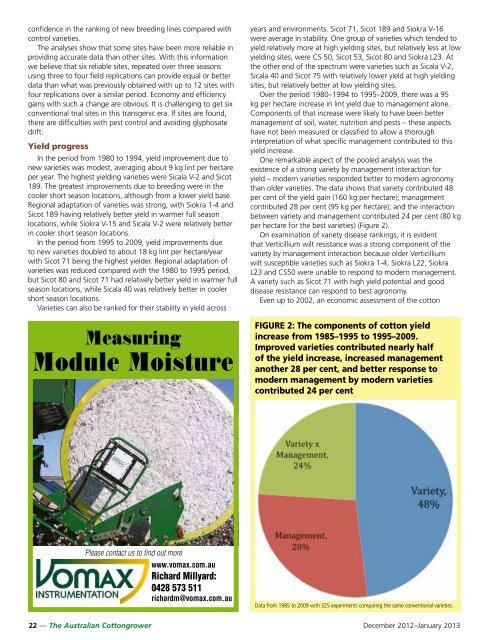cotton - Greenmount Press
cotton - Greenmount Press
cotton - Greenmount Press
You also want an ePaper? Increase the reach of your titles
YUMPU automatically turns print PDFs into web optimized ePapers that Google loves.
confidence in the ranking of new breeding lines compared with<br />
control varieties.<br />
The analyses show that some sites have been more reliable in<br />
providing accurate data than other sites. With this information<br />
we believe that six reliable sites, repeated over three seasons<br />
using three to four field replications can provide equal or better<br />
data than what was previously obtained with up to 12 sites with<br />
four replications over a similar period. Economy and efficiency<br />
gains with such a change are obvious. It is challenging to get six<br />
conventional trial sites in this transgenic era. If sites are found,<br />
there are difficulties with pest control and avoiding glyphosate<br />
drift.<br />
Yield progress<br />
In the period from 1980 to 1994, yield improvement due to<br />
new varieties was modest, averaging about 9 kg lint per hectare<br />
per year. The highest yielding varieties were Sicala V-2 and Sicot<br />
189. The greatest improvements due to breeding were in the<br />
cooler short season locations, although from a lower yield base.<br />
Regional adaptation of varieties was strong, with Siokra 1-4 and<br />
Sicot 189 having relatively better yield in warmer full season<br />
locations, while Siokra V-15 and Sicala V-2 were relatively better<br />
in cooler short season locations.<br />
In the period from 1995 to 2009, yield improvements due<br />
to new varieties doubled to about 18 kg lint per hectare/year<br />
with Sicot 71 being the highest yielder. Regional adaptation of<br />
varieties was reduced compared with the 1980 to 1995 period,<br />
but Sicot 80 and Sicot 71 had relatively better yield in warmer full<br />
season locations, while Sicala 40 was relatively better in cooler<br />
short season locations.<br />
Varieties can also be ranked for their stability in yield across<br />
Measuring<br />
Module Moisture<br />
years and environments. Sicot 71, Sicot 189 and Siokra V-16<br />
were average in stability. One group of varieties which tended to<br />
yield relatively more at high yielding sites, but relatively less at low<br />
yielding sites, were CS 50, Sicot 53, Sicot 80 and Siokra L23. At<br />
the other end of the spectrum were varieties such as Sicala V-2,<br />
Sicala 40 and Sicot 75 with relatively lower yield at high yielding<br />
sites, but relatively better at low yielding sites.<br />
Over the period 1980–1994 to 1995–2009, there was a 95<br />
kg per hectare increase in lint yield due to management alone.<br />
Components of that increase were likely to have been better<br />
management of soil, water, nutrition and pests – these aspects<br />
have not been measured or classified to allow a thorough<br />
interpretation of what specific management contributed to this<br />
yield increase.<br />
One remarkable aspect of the pooled analysis was the<br />
existence of a strong variety by management interaction for<br />
yield – modern varieties responded better to modern agronomy<br />
than older varieties. The data shows that variety contributed 48<br />
per cent of the yield gain (160 kg per hectare); management<br />
contributed 28 per cent (95 kg per hectare); and the interaction<br />
between variety and management contributed 24 per cent (80 kg<br />
per hectare for the best varieties) (Figure 2).<br />
On examination of variety disease rankings, it is evident<br />
that Verticillium wilt resistance was a strong component of the<br />
variety by management interaction because older Verticillium<br />
wilt susceptible varieties such as Siokra 1-4, Siokra L22, Siokra<br />
L23 and CS50 were unable to respond to modern management.<br />
A variety such as Sicot 71 with high yield potential and good<br />
disease resistance can respond to best agronomy.<br />
Even up to 2002, an economic assessment of the <strong>cotton</strong><br />
FIGuRE 2: The components of <strong>cotton</strong> yield <br />
increase from 1985–1995 to 1995–2009. <br />
Improved varieties contributed nearly half <br />
of the yield increase, increased management <br />
another 28 per cent, and better response to <br />
modern management by modern varieties <br />
contributed 24 per cent<br />
Please contact us to find out more<br />
www.vomax.com.au<br />
Richard Millyard:<br />
0428 573 511<br />
richardm@vomax.com.au<br />
Data from 1985 to 2009 with 325 experiments comparing the same conventional varieties.<br />
22 — The Australian Cottongrower December 2012–January 2013

















